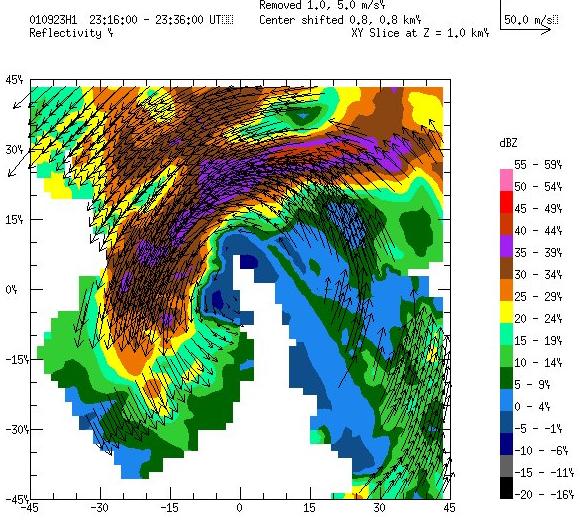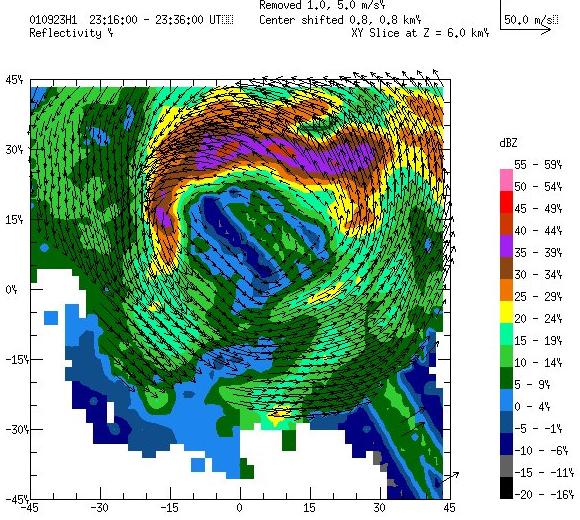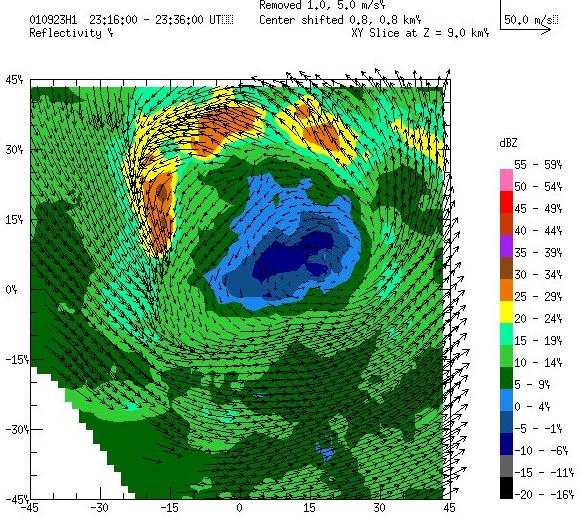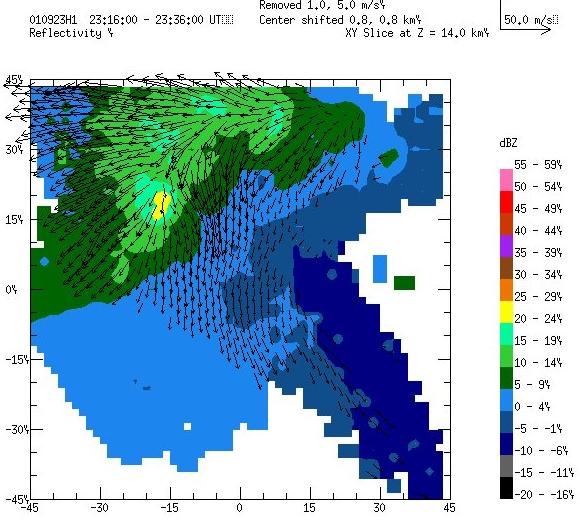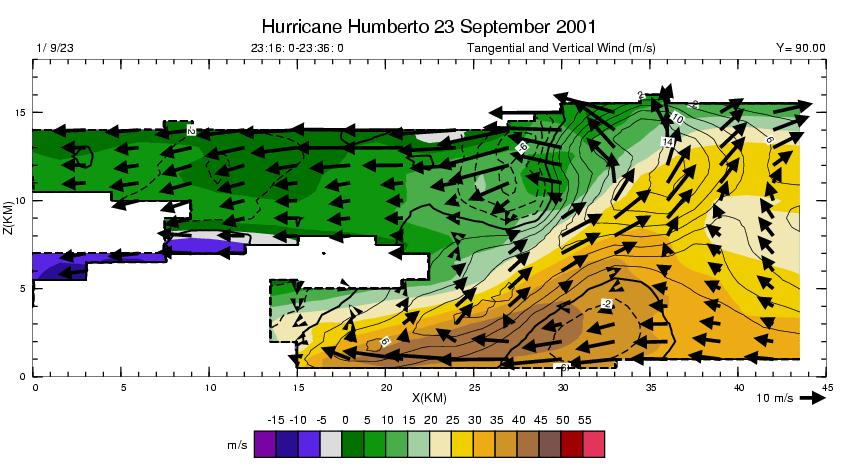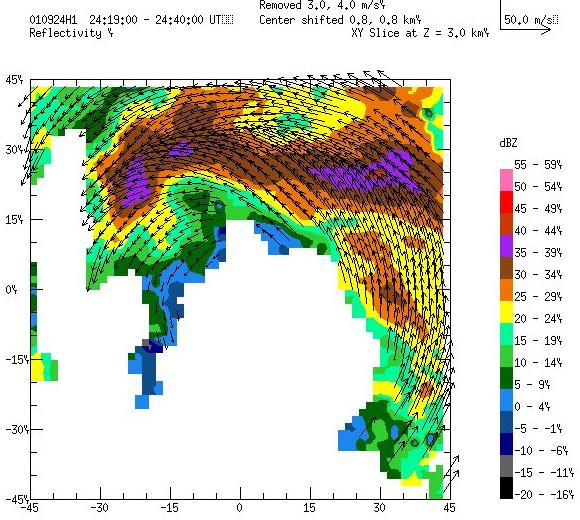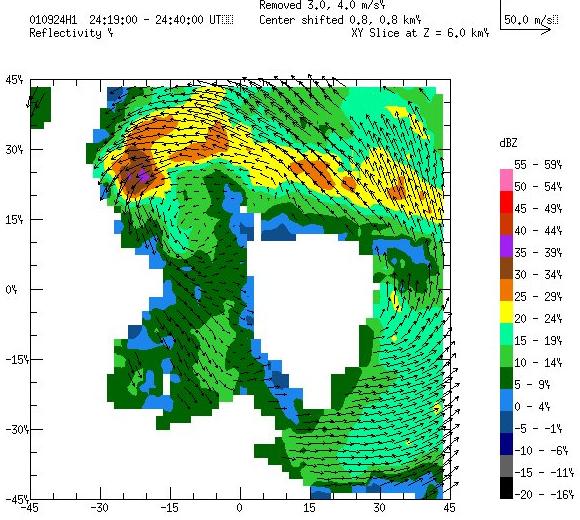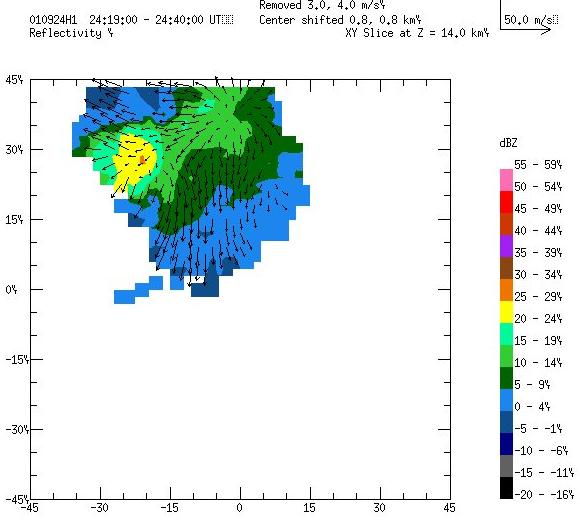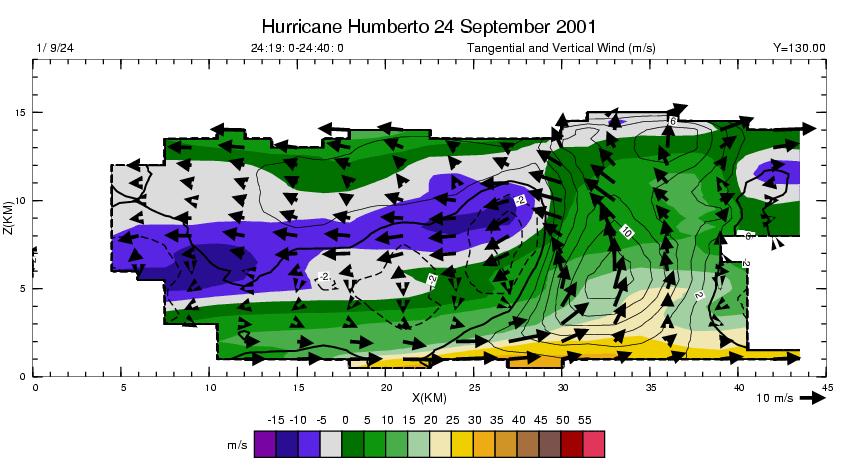|
Humberto COVES Experiment
John Gamache (HRD)
Team Members :
Collaborators : Objective: The purpose of the Coordinated Observations of Vortex Evolution and Structure (COVES) experiment is to produce two complete, successive three-dimensional "snapshots" of a mature TC undergoing a significant period of strengthening or weakening. It fulfills one of the foremost objectives of the U.S. Weather Research Program's (USWRP) Hurricane Landfall 2001 (HL2001) initiative. A syncrhonized five-aircraft COVES experiment, which involved a joint interagency effort between NOAA and NASA, was undertaken in Hurricane Humberto on 23 and 24 September 2001. Simultaneous in situ and remote-sensed kinematic, thermodynamic, and microphysical observations comprising several spatial resolutions were collected from airborne instruments and probes released during the two missions. These data allow the structure and temporal evolution of Humberto and its environment to be mapped vertically throughout the depth of the troposphere and down to approximately 200 m below the sea surface and horizontally out to 1000 km from the storm center. Analyses of the detailed, high-quality observations on a multiplicity of scales are to be used to achieve an improved understanding of the intensity change processes. The data analyses can then be applied to the study and simulation of how tropical cyclone (TC) intensity is modulated by environmental forcing and wind shear, interactions of the coupled atmosphere-ocean system, and internal dyanmics. Other applications include accurate validation and intercomparisons of instrument measurements, initialization and evaluation of full-physics TC simulations and data assimilation techniques, and the development of the next generation of high-resolution dynamical and mesoscale models.
The group will then utilize the analyses and derived products in applications to:
Methodology : Doppler Radar Data Airborne Doppler data are interpolated into a grid. The data from two or more radars are synthesized using a variational analysis that minimizes the cost function. The cost function includes:
Dropsonde, Rawinsonde, P-3 Flight Level, and GOES Satellite Wind Data The dropsonde data are first post-processed to correct for errors and eliminate observational noise. The data from each sonde is then smoothed with a 100 mb low-pass filter and sampled every 50 mb. The rawinsonde data are also smoothed and sampled in a similar manner. A 60 s low-pass filter is applied to P-3 flight level data, and they are sampled temporally at resolutions similar to the spacing between the dropsonde observations. Processed visible, IR, and water vaport channel GOES satellite wind observations were obtained from Chris Velden of CIMSSat the University of Wisconsin. Wind observations from the dropsonde, rawinsonde, P-3 aircraft, and satellite platforms within ± six hours of the central nominal analysis time were analyzed using the nested HRD spline analysis (HSA) techniques. The HSA procedures are similar to those outlined by Franklin et al. (1996) and Feuer and Kaplan (1995) for analyzing winds in the storm environment and by Franklin et al. (1993) for analyzing winds in the inner core and environment of Hurricane Gloria of 1985. A multiply nested scheme is used to resolve various regions of Humberto and the surrounding atmospheric flow. The filter wavelengths on each mesh are chosen to be representative of the desired resolution scale and compatible with the average spacing of the data. Circular arrays of synthetic winds with values determined by a scanning algorithm are employed to constrict the vortex inner core, fill data void regions, and prevent aliasing. In the later stages of the project, detailed kinematic and thermodynamic analyses that integrate all of the data sets from the different probes and instruments will be produced using the full HSA procedure, including the vertical iteration steps. Accomplishments : Preliminary analyses of airborne Doppler observations of the core of Hurricane Humberto have been performed for the third (final) eye penetrations of COVES Missions 1 and 2. For both missions the tail Doppler radar aboard N42RF was operating in a Fore/Aft (FAST) scanning mode, in which the antenna scans in alternating cones 20 degrees fore and aft of the plane perpendicular to the fuselage (Gamache et al. 1995; Jorgensen et al. 1996). This actually permitted a three-dimensional wind field to be determined from observations collected during a single flight leg by only one aircraft. N43RF, however, was flying in a coordinated pattern normal to N42RF; and the tail Doppler radar was scanning continuously in the plane perpendicular to the flight track. Consequently, simultaneous observations from both aircraft were incorporated into one Doppler-wind analysis for each mission. Since GPS data provided the locations to within 100 m, the radar observations from the two moving aircraft could accurately be mapped together. This yielded a somewhat more complete depiction of the wind field, in which there were three independent observations from the two radars in some locations. The three-dimensional wind analyses were produced using a three-step process involving perusal and editing, construction of a data composite, and interpolation and variational synthesis. For both Humberto COVES missions, a set of preliminary objective, multi-scale, filtered analyses of the GPS dropsonde, rawinsonde, WP-3D aircraft, and GOES cloud-track wind observations have been produced at representative horizontal pressure levels in the upper and middle troposphere and throughout the depth of the lower troposphere. These levels are 200 mb (includes observations over a 150-250 mb layer), 550 mb (includes observations over a 500-600 mb layer), 700-950 mb at regular 50 mb intervals, and the surface. All data within 6 h of the central nominal time designated for each mission were analyzed using the nested HSA software; the time was set at 0000 UTC on 24 September for Mission 1 and 0000 UTC on 25 September for Mission 2. A consistent three-mesh HSA scheme was used at all horizontal levels to depict different regions of Humberto and its surrounding flow. No vertical iterative steps though were taken to ensure consistency and mass continuity between the levels. Calculations and plots were made for many diagnostic quantities derived from the analyzed wind fields, including azimuthally-averaged wind, storm-relative wind, asymmetric residual wind, perturbation wind, relative vorticity, divergence, radial wind, tangential wind, and environmental shear between different levels. Radial mean profiles were produced for some of these quantities. Upper-ocean thermal analyses were produced from two primary data sources: in situ vertical temperature profiles from AXBTs launched during both Humberto COVES missions and SSTs derived from satellite infrared radiometry. The AXBTs were post-processed using established QC measures. The satellite-derived SST measurements were obtained from the NOAA/NASA Pathfinder Advanced Very High Resolution Radiometer (AVHRR) SST data set. They were averaged over an 8-day period from 14-22 September, just prior to the passage of Humberto, and provided on a 9 km-resolution grid by NASA's Jet Propulsion Laboratory (JPL). The AVHRR-derived data were then blended with the AXBT SST observations in weighted averages via an optimal interpolation scheme at 11.1 km resolution. Studies and numerous group discussions of Humberto's structure deduced from the preliminary analyses have been ongoing, including documentation of the inner core wavenumber one and two asymmetries in and above the boundary layer; distribution of convective-scale, eyewall/mesoscale, and vortex-scale wind asymmetries as they relate to convection and environmental shear; and upper ocean thermal structure beneath the hurricane. Also, using the analysis results, the group has been exploring how shear, synoptic-scale features, internal dynamics, and oceanic interactions may have contributed to the storm's change in intensity during COVES. Work has begun concurrently on two manuscripts --one presenting an overview of the Humberto COVES experiment and discussing the synoptic-scale and vortex-scale analysis results and the other describing and intrepeting the eyewall/mesoscale and convective-scale features from the Doppler-radar analyses. Additionally, sampled HSA-produced surface wind fields have been provided to Ed Walsh (NASA/GFSC/WFF) for a study of Humberto's impact on ocean wave field properties; the results have been reported in a pending manuscript submitted to the Journal of Atmospheric Science.
Fig. 1 An animation showing the reflectivity and storm-relative wind field at each height from .5 km to 16 km at 2330 UTC on 23 September 2001. Height is shown in each frame. Domain extends from 45 km south and west of the low-level circulation center to 45 km north and east of the circulation center.
Fig. 4 An animation showing the reflectivity and storm-relative wind field at each height from .5 km to 16 km at 0030 UTC on 25 September 2001. Height is shown in each frame. Domain extends from 45 km south and west of the low-level circulation center to 45 km north and east of the circulation center. 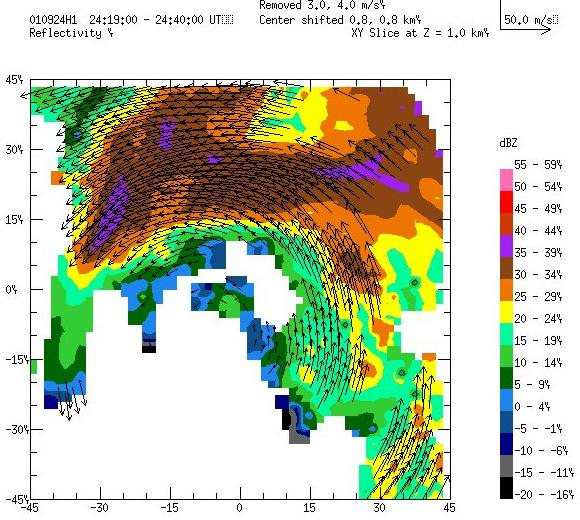 (a)
Milestones:
References :
Feuer, S.E., J.F. Gamache, M.L. Black, F.D. Marks, and J.B. Halverson.
2002 : "A multiple aircraft experiment in Hurricane Humberto (2001),
Part I: Wind fields." Preprints, 25th Conf. Hurr. Trop. Meteor.,
San Diego, CA, Amer. Meteor. Soc., pp.206-207
Gao, Jidong, Xue, Ming, Shapiro, Alan, Droegemeier, Kelvin K. 1999:
"A Variational Method for the Analysis of Three-Dimensional Wind
Fields from Two Doppler Radars." Mon. Wea. Rev.,
127, pp.2128-2142
Gamache, J. F., F. D. Marks, Jr., and F. Roux, 1995: Comparison of
Three Airborne Doppler Sampling Techniques with Airborne In Situ
Wind Observations in Hurricane Gustav (1990). J. Atmos. Ocean.
Tech., 12, 171-181.
Jorgensen, D. P., T. Matejka, and J. D. DuGranrut, 1996: Multi-beam
techniques for deriving widn fields from airborne Doppler radar.
J. Meteor. Atmos. Phys., 59, 83-104.
Feuer, S.E., J. Kaplan, 1995 : "Tropical Cyclone intensity change
and environmental kinematic structure in Omega dropwindsonde
datasets." Preprints, 21st Conf. Hurr. Trop.Meteor.,
Miami, FL, Amer. Meteor. Soc., pp.363-364
Franklin, J.L., S.E.Feuer,J. Kaplan, S.D. Aberson, 1996 :
"Tropical Cyclone motion and surrounding lfow relationships :
Searching for beta-gyres in Omega dropwindsonde datasets."
Mon. Wea. Review, 124 pp.64-84
Franklin, J.L., S.J. Lord, S.E. Feuer, F.D. Marks Jr., 1993 :
"The kinematic structure of Hurricane Gloria (1985) determined
from nested analyses of dropwindsonde and Doppler radar data."
Mon. Wea. Review, 121 pp.2433-2451.
Last modified: 1/16/2004 |
Links of Interest
AOML Tools & Resources
Employee Tools
|
